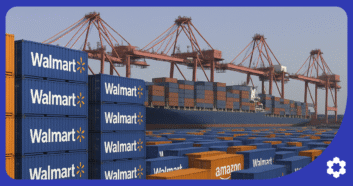Top Amazon Seller News This Week
This week’s roundup dives into Amazon’s alleged quiet return to restock limits, evolving ad strategies under tariff pressure, and how sellers are adapting pricing and storage tactics to navigate rising costs.
- Amazon softens pricing penalties amid tariff pressures, but overall prices stay steady: Amazon is now letting top sellers raise prices—up to 25%—without penalties like Buy Box suppression. Yet, price data shows only slight increases in a few categories, with many prices still trending down, keeping overall marketplace costs fairly stable.
- Tariffs reshape ad strategies as brands lean into Amazon and rivals pull back: Amid economic uncertainty, US advertisers are boosting spend on Amazon’s DSP and search ads, while Temu and Shein cut Google Shopping budgets and plan price hikes due to tariffs and the end of the de minimis exception.
- Did Amazon quietly reintroduce restock limits for FBA sellers?: According to Marketplace Prep, Amazon has reintroduced Restock Limits on a per-ASIN basis, similar to those from the 2020–2021 pandemic. Despite no formal announcement, sellers began seeing shipment blocks in April 2025, with inventory capped at around 90 days per ASIN. Conflicting metrics and lack of clarity have left sellers frustrated and preparing for peak-season challenges.
As tariffs, restock limits, and changing ad strategies reshape the landscape, sellers face a high-stakes balancing act—navigating costs, inventory, and visibility while staying agile for what’s next.
Back in the Box: Sellers Win Amid Signs of Tariff Relief
As the US-China tariff war rattles global supply chains, Amazon sellers are navigating shifting tariffs, pricing rules, and penalties. But new developments suggest the tides may be turning—at least for now.
Amazon Loosens Buy Box Penalties
Just weeks ago, Amazon reportedly penalized top sellers for raising prices too rapidly in response to steep US tariffs on Chinese imports.
The punishment? Loss of the all-important Buy Box, which dramatically reduces sales. Even brand owners selling exclusively on their Amazon listings weren’t spared, despite matching prices across all platforms.
Now, Amazon seems to be reversing course.
Several sellers report their Buy Boxes have quietly returned—even with price hikes of 20–25% still active. A home furnishings CEO said his company lost the Buy Box across many products after raising prices about 20% due to new 145% tariffs on Chinese imports.But as of Monday, the Buy Box quietly returned, even with the same price hikes. Some sellers also reported their listings were no longer being suppressed, suggesting Amazon may be easing up—possibly in response to recent media attention, though the exact reason remains unclear.
Prices Hold Steady—For Now
Despite US tariffs, major price spikes haven’t materialized yet, according to Wired. Tracking data from Keepa and CamelCamelCamel shows only slight increases in a few categories like automotive and arts & crafts.
Here’s why:
- Many sellers are working through older, tariff-free inventory.
- Fear of triggering Amazon’s “fair pricing” penalties keeps price hikes in check.
- Sellers are holding off, waiting to see if tariff rates drop.
Some are quietly adapting:
- Raising minimums in pricing tools.
- Using value-focused messaging (“affordable luxury”).
- Exploring workarounds like transshipping or “substantial transformation” to shift country-of-origin labeling.
Tariff Rollbacks on the Horizon?
There may be relief ahead. President Trump recently hinted that the extreme tariffs “will come down substantially,” suggesting a softer stance after weeks of hardline rhetoric. Treasury Secretary Scott Bessent also called the trade war “unsustainable,” fueling hopes of a de-escalation.
Markets reacted swiftly—Wall Street and Asian indexes surged. Still, with US-China relations in flux, uncertainty remains.
Tariffs Shake Up Ad Spending: Amazon Gains as Temu and Shein Retreat
While Chinese giants Temu and Shein scale back their US marketing efforts, American brands are doubling down on Amazon’s performance-driven ad platforms to keep sales strong in a tightening market.
Amazon’s Ad Channels Surge Amid Tariff Jitters
Faced with mounting costs and fears of recession, US brands are shifting more of their marketing spend toward Amazon’s search ads and Demand-Side Platform (DSP)—tools known for targeting power and measurable return on investment.
- According to DigiDay, Pacvue’s latest report showed that brand spending on Amazon’s Sponsored Products and Sponsored Brands increased 9% in Q1 2025 compared to the previous year.
- Investment in Amazon’s DSP—used for ads on Prime Video and offsite placements—soared by 25.4% year-over-year.
- Tinuiti, a major marketing agency, reported a 29% jump in Prime Video ad spending from Q4 2024 to Q1 2025.
For Swapnil Patel, Managing Director at McKinney, Amazon is now a go-to for brands trying to drive efficient growth. With consumer confidence dropping and ad budgets tightening, Amazon’s data-rich, performance-focused platform is seen as a safer bet in uncertain times.
Expand your reach with DSP Prime. Our expert-managed advertising solution leverages Amazon’s first-party data to connect your brand with high-intent audiences across websites, apps, and streaming platforms. Get your customized growth plan now and launch in just 10 days.
Meanwhile, Temu and Shein Pull Back
In stark contrast, Temu and Shein have drastically reduced their US advertising, citing tariff hikes and the imminent end of the de minimis rule (which exempted goods under $800 from duties).
- In a data shared with Practical Commerce, Tinuiti revealed that Temu stopped all Google Shopping ads between April 9 and 12, while Shein slashed theirs on April 15.
- Both platforms will increase prices starting April 25, anticipating the end of the de minimis exemption on May 2.
These moves suggest a reduced role for the fast-growing discount online stores in the US, potentially opening space for others.
Who Stands to Gain?
- Ad buyers, who may face less competition for premium ad placements, especially on Google Shopping and Amazon.
- Discount retailers, who’ve long battled Temu and Shein for budget-conscious shoppers.
- Small ecommerce businesses, especially those selling low-cost products not sourced from China, who may now find a more level playing field.
However, analysts caution that the benefit might be muted—many competitors still rely on Chinese manufacturing and other global supply chains vulnerable to tariffs.
Boost your Amazon rank with our Organic Ranking white paper. Our latest guide delivers smart, straightforward strategies for enhancing organic rankings through external traffic, listing optimization, and paid ad campaigns. Download your free ranking guide now.
Amazon Restock Limits: Is 2025 a Repeat of 2021?
There’s been a growing buzz among Amazon sellers—restock limits might be coming back in 2025. While nothing has been officially confirmed by Amazon, the chatter on LinkedIn and seller forums is picking up steam.
What’s Going On With Restock Limits?
James McConnell Jr., a seasoned Amazon strategist and the mind behind Marketplace Prep, first noticed the resurgence of restock-related errors around April 8, 2025. His article gives an in-depth analysis and the latest developments.
Unlike the account-wide Capacity Limits, Restock Limits now target individual ASINs, making it much harder for sellers to maintain stock—even for fast-selling products.
Here are the key developments:
- Amazon is reportedly enforcing a 90-day inventory cap on an ASIN level at Fulfillment Centers (FCs). Exceed that, and you may see errors like:
- “You already have high days of supply for this ASIN…”
- “This product has a maximum inventory level and exceeds the allowed quantity.”
- These limitations are being enforced even if your inventory is about to run out, and even if Amazon’s own system flags it as “low stock.”
- Amazon’s Days of Supply metric is lagging and doesn’t always reflect current demand. It often penalizes products that were previously out of stock or are in high demand due to recent promotions or virality.
- To make matters worse, these new inventory limits apply to:
- Individual sellers
- Specific ASINs
- And possibly, all sellers on a shared ASIN listing (though Amazon is contradicting itself here—more on that later).
How It’s Affecting Sellers
According to McConnell, the potential return of restock limits in 2025 could trigger a chain reaction of seller pain points.
- The Domino Effect
A seller restocks 100 units of a product that sells out quickly. Because of the delay in processing and recalibrating Days of Supply, they can’t send in more units for weeks—even though sales show the product is in high demand. This leads to stockouts, lost sales, and potential low-level inventory fees due to Amazon’s own limitations.
- The Meltable Effect
Seasonal or temperature-sensitive products (like chocolates in Q4) face a different beast. Amazon recommends sending in inventory 6–8 weeks before peak. But if the “meltable” window hasn’t opened yet or you’re blocked by limits, how do you build stock? Short answer: you can’t.
- The ASIN-Tug-of-War
Amazon’s Strategic Account Services (SAS) Core says your Days of Supply is based only on your metrics. Yet their help page confirms: one seller overstocking an ASIN can block others from sending in units—even if they have zero inventory.
Confused? So are sellers. And so, it seems, is Amazon.
So what can you do about it?
While we wait for clearer guidance from Amazon (don’t hold your breath), here are some strategies to help you adapt:
Monitor Your Metrics Like a Hawk
- Track your Days of Supply, sell-through rate, and historical stockouts
- Use Amazon’s “Low Stock” flag to spot true restock signals.
Improve Your Forecasting & Inventory Turnover
- Plan for just-in-time restocking
- Work backward from expected lead times and processing delays
- Adjust your supply chain inputs in the Restock Dashboard—even if Amazon seems to ignore them
Take control of your inventory with SoStocked. Our forecasting prevents stockouts and costly storage fees by predicting demand, automating reorder points, and preventing fees. See your recommended actions before it’s too late.
Diversify Fulfillment Channels
- Consider 3PLs or your own warehouse as a buffer
- Look into FBM. Don’t rely solely on FBA—especially for new or fast-scaling SKUs
Advocate for Your ASINs
- Open Seller Support cases for seasonal items
- Provide sales history and projected demand
- Flag contradictory restrictions—especially if your ASIN is flagged as both “overstocked” and “low stock”
Join the Conversation
- Stay active in seller communities (like LinkedIn, Seller Forums, or Facebook groups)
- Share screenshots, patterns, and case outcomes to crowdsource insight
- Follow updates from experts who are deep in the trenches
Other Amazon Seller Updates This Week
1. Sellers Use Cross-Border Storage to Navigate Tariffs
Walmart and Amazon sellers are stashing goods in Canadian warehouses to delay or avoid US tariffs, viewing the added $500–$600 per container as a worthwhile cost for potential duty relief.
2. Amazon Expands Low-Cost Store
Amazon has expanded its low-cost “Haul” store, moving from a mobile-only beta to desktop access. Product assortment now includes branded items, timed strategically amid US tariffs on direct-from-China shipments, creating challenges for cross-border ecommerce.
3. US Pushes for Full Market Access in India
The US government is urging India to grant Amazon and Walmart full access to its $125 billion ecommerce market. This push is part of broader trade negotiations aimed at creating a level playing field for online retail.
4. Amazon Launches Father’s Day Promotions
Amazon is running a dedicated Father’s Day Shop through June 15, featuring discounts on holiday-themed products across categories like tech, grilling, and apparel. Shoppers can filter products by persona (techie, sporty, outdoorsy) and budget, with brands like Beats, LeCruset, and Adidas highlighted.
5. Amazon Q1 2025 Earnings Report
Amazon will release its Q1 2025 financial results on May 1. A conference call will be held at 2:00 p.m. PT/5:00pm ET, available live and for future viewing.
6. Amazon Scales Back AI Investments?
Amazon joins major tech companies, like Microsoft, in slowing down AI infrastructure spending due to economic uncertainty. The company has paused certain data center leases, signaling broader industry challenges as tariffs and economic conditions impact financial markets.
Unlock the future of ecommerce with our AI Revolution white paper. Discover how leading Amazon sellers leverage AI for personalization, product research, and advertising optimization. Download your free guide now and start integrating AI.
Your Playbook for the Road Ahead
While Amazon’s easing of Buy Box penalties and potential tariff relief offer a temporary breather, sellers are still contending with ASIN-level restock limits, ad competition, and logistical uncertainty. Staying proactive, data-driven, and diversified will help you weather the storm and turn disruption into opportunity.
Here are a few actionable steps to help you navigate the latest changes:
- Recalibrate pricing with confidence: If you’re a top seller, test moderate price increases (up to 25%)—Amazon may no longer penalize them.
- Double down on Amazon ads: Shift budget toward DSP where ROI is strongest—especially as competitors retreat.
- Outsmart potential restock limits: Track sell-through daily and stagger inbound shipments to stay under 90-day caps without running dry.
- Push for manual stock level reviews: When restock limits block key ASINs, submit detailed cases to Seller Support—including forecasted sales and past velocity.
- Use 3PL as a pressure valve: Relieve FBA bottlenecks by routing overflow inventory to third-party warehouses and fulfillment centers with faster turnarounds.
For nearly four years, we’ve kept sellers informed with our Amazon Sellers Newsletter, publishing over 200 issues packed with policy changes, announcements, and community events. Subscribe or share with your team to get these insights delivered weekly.




